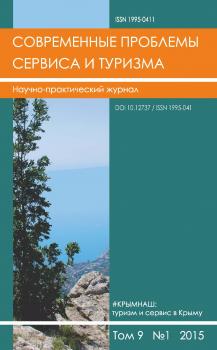The article is devoted to study the role of intangible cultural heritage in the development of modern urban areas. Modern cities are experiencing a transformational load associated with the transition from industry to the post-in- dustry – service industry comes on the place of the plants, and one of the leading sectors becomes tourism. Social and environmental factors on the one hand, reflect the general level of development of the city and, on the other hand, in a post-industrial economy are the main actors in the development of all areas, including city tourism. Intangible cultural heritage is seen as a social factor, the formation of which is related to the environment (natural- ecological spheres), and history of the city. Intangible cultural heritage serves as a catalyst for the creative economy and the events of the city, which in turn have a positive impact on city tourism. The city squares, streets, parks are becoming the immediate territorial areas, where the intangible cultural heritage are demonstrated to the citizens and tourists and their level of status, comfort and attractiveness depends largely on the implementation of the tourism potential of the intangible heritage. Cities skillfully combining the intangible heritage, creative industries, event and educational tourism receive an additional impulse for the development of city tourism and the whole economy of the city. The Republic of Tatarstan last decade is actively moving towards the formation of territorial attractive tourism product. Kazan has ranked among the leading cities of domestic tourism sector. Moreover, any tourism city is interested in attracting more tourists for longer periods, which is possible due to the diversity of the program in the city or region. Intangible cultural heritage can play an important role in solving this problem. In the article using the example of the three cities of the republic – Kazan, Chistopol and Elabuga – is shown as a combination of social factors, such as intangible cultural heritage, and natural factors can create an attractive tourism route. Publication of the article was supported by Russian Humanitarian Research Foundation and government of the Republic of Tatarstan as part of scientific project № 15–13–16004.
city, urban areas, social and environmental aspects, city tourism, intangible heritage
1. Abashev V.V., Firsova A.V. Site sketch: literature as a guide-book. Vestnik Permskogo universiteta. Rossijskaja i zaru- bezhnaja filologija [Perm University Herald. Russian and Foreign Philology], 2010, No. 4 (10), pp. 98-104 (In Russ.).
2. Zamjatin D.N. Methodological and theoretical foundations of modeling geographic images. Gumanitarnaja geo- grafija: nauchnyj i kul’turno-prosvetitel’skij al’manah [Humanitarian geography: scientific, cultural and educational almanac], 2006, No. 3, pp. 19-44. (In Russ.).
3. Firsova A.V. Role of fiction in modeling geographical image (by the example of Perm). Geograficheskii vestnik [Geo- graphical bulletin], 2015, No4 (35), pp. 53-57. (In Russ.).
4. Khusnutdinova S.R. The exhibitions as event-tourism and their role in socio-economic development of the city. Sovremennye problemy nauki i obrazovanija [Modern problems of science and education], 2012, No. 3. URL: http://www.science-education.ru/ru/article/view?id=6214 (Accessed on December 04, 2015). (In Russ.).
5. Khusnutdinova S.R., Safonova M.V. Education through travel as a trend of city tourism. Fundamental’nye issledo- vanija [The Fundamental Researches], 2014, No. 5, part 5, pp. 1037-1040. (In Russ.).
6. Al-hagla K. Sustainable urban development in historical areas using the tourist trail approach: A case study of the Cultural Heritage and Urban Development (CHUD) project in Saida, Lebanon. Cities, 2010, vol. 27, No. 4, pp. 234-248.
7. Dallen J. Timothy Cultural heritage and tourism: an introduction. B.: CVB, 2011. 463 p.
8. Graham B. Heritage as Knowledge: Capital or Culture? Urban Studies, 2002, No. 39, pp. 1003-1017.
9. Maitland R., Ritchie B. City tourism: national capital perspectives. UK: Cab International, 2010. 279 p.
10. Richards G. Creativity and tourism: The State of the Art. Annals of Tourism Research, 2008, vol. 38, No. 4, pp. 1225- 1253.
11. Richards G., Wilson J. Developing creativity in tourist experiences: A solution to the serial reproduction of culture? Tourism Management, 2006, vol. 27, No. 6, pp. 1209-1223.
12. Russo P.A., Borg J. Planning considerations for cultural tourism: a case study of four European cities. Tourism Man- agement, 2002, vol. 23, No. 6, pp. 631-637.





